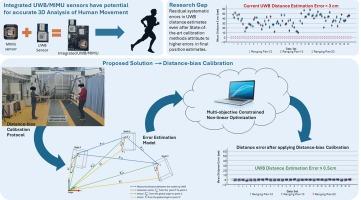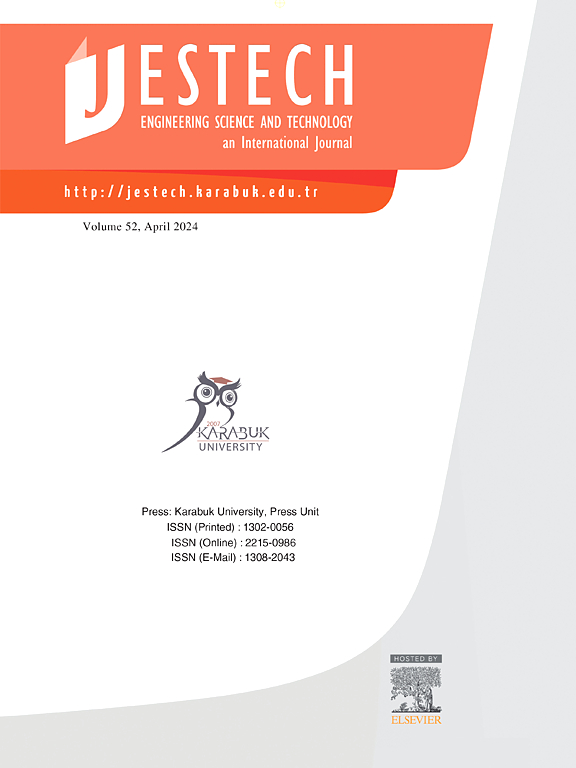Novel calibration method for improved UWB sensor distance measurement in the context of application for 3D analysis of human movement
IF 5.4
2区 工程技术
Q1 ENGINEERING, MULTIDISCIPLINARY
Engineering Science and Technology-An International Journal-Jestech
Pub Date : 2024-10-01
DOI:10.1016/j.jestch.2024.101844
引用次数: 0
Abstract
Integrated UWB and MIMU sensor systems have become popular for pedestrian tracking and indoor localization, since this facilitates data fusion that improves position estimation accuracy by exploiting the complementary nature of their error sources. Integrated UWB/MIMU sensors also have great potential in only on-body use for 3D analysis of human movement, as with MIMU sensors alone accurate direct estimation of (relative) body segment position is not possible. For this, a position estimation accuracy with errors smaller than 1 cm is deemed required. The lowest position estimating error with integrated UWB/MIMU systems, reported so far, is around 5 cm. The main accuracy limiting factors were found to be the systematic errors in the distance estimates from the UWB sensor. Multiple reported attempts to calibrate for these systematic errors failed to achieve the desired accuracy. This article presents a novel distance-bias calibration method that minimizes the residual systematic distance estimate errors using multiple sensors in a swarm configuration. Validation was performed against synthetic reference data and against reference data measured with an optical motion tracking system. Significantly reduced systematic distance estimate errors (≤0.5 cm) were found. These results promise to facilitate significantly better position estimates in future UWB/MIMU data fusion.

改进 UWB 传感器距离测量的新型校准方法在人体运动 3D 分析中的应用
集成式 UWB 和 MIMU 传感器系统在行人跟踪和室内定位方面很受欢迎,因为这有利于数据融合,通过利用其误差源的互补性来提高位置估计精度。集成式 UWB/MIMU 传感器在人体三维人体运动分析方面也具有巨大潜力,因为仅使用 MIMU 传感器无法直接准确估计(相对)体段位置。因此,需要误差小于 1 厘米的位置估计精度。迄今为止,UWB/MIMU 集成系统的最低位置估计误差约为 5 厘米。限制精度的主要因素是 UWB 传感器距离估计中的系统误差。报道中多次尝试对这些系统误差进行校准,但都未能达到预期精度。本文介绍了一种新颖的距离偏差校准方法,该方法利用蜂群配置中的多个传感器将残余的系统距离估计误差降至最低。根据合成参考数据和光学运动跟踪系统测量的参考数据进行了验证。结果发现,系统距离估计误差显著降低(≤0.5 厘米)。这些结果有望在未来的 UWB/MIMU 数据融合中大大改进位置估计。
本文章由计算机程序翻译,如有差异,请以英文原文为准。
求助全文
约1分钟内获得全文
求助全文
来源期刊

Engineering Science and Technology-An International Journal-Jestech
Materials Science-Electronic, Optical and Magnetic Materials
CiteScore
11.20
自引率
3.50%
发文量
153
审稿时长
22 days
期刊介绍:
Engineering Science and Technology, an International Journal (JESTECH) (formerly Technology), a peer-reviewed quarterly engineering journal, publishes both theoretical and experimental high quality papers of permanent interest, not previously published in journals, in the field of engineering and applied science which aims to promote the theory and practice of technology and engineering. In addition to peer-reviewed original research papers, the Editorial Board welcomes original research reports, state-of-the-art reviews and communications in the broadly defined field of engineering science and technology.
The scope of JESTECH includes a wide spectrum of subjects including:
-Electrical/Electronics and Computer Engineering (Biomedical Engineering and Instrumentation; Coding, Cryptography, and Information Protection; Communications, Networks, Mobile Computing and Distributed Systems; Compilers and Operating Systems; Computer Architecture, Parallel Processing, and Dependability; Computer Vision and Robotics; Control Theory; Electromagnetic Waves, Microwave Techniques and Antennas; Embedded Systems; Integrated Circuits, VLSI Design, Testing, and CAD; Microelectromechanical Systems; Microelectronics, and Electronic Devices and Circuits; Power, Energy and Energy Conversion Systems; Signal, Image, and Speech Processing)
-Mechanical and Civil Engineering (Automotive Technologies; Biomechanics; Construction Materials; Design and Manufacturing; Dynamics and Control; Energy Generation, Utilization, Conversion, and Storage; Fluid Mechanics and Hydraulics; Heat and Mass Transfer; Micro-Nano Sciences; Renewable and Sustainable Energy Technologies; Robotics and Mechatronics; Solid Mechanics and Structure; Thermal Sciences)
-Metallurgical and Materials Engineering (Advanced Materials Science; Biomaterials; Ceramic and Inorgnanic Materials; Electronic-Magnetic Materials; Energy and Environment; Materials Characterizastion; Metallurgy; Polymers and Nanocomposites)
 求助内容:
求助内容: 应助结果提醒方式:
应助结果提醒方式:


